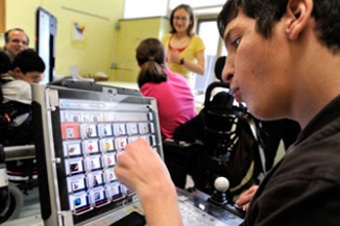Mobile communication technologies can play a major role catering to the world's one billion disabled people, according to an independent study published in the UK today. But that role is not yet being fulfilled.
June 2, 2014

Mobile communication technologies can play a major role catering to the world’s one billion disabled people, according to an independent study published in the UK today. But that role is not yet being fulfilled.
A Telefónica-commissioned report, carried out by market researcher Chris Lewis, focuses on the “untapped billion” – the number of people the World Health Organisation estimates have some form of disability. The report looks at the issues of accessibility in the increasingly digital world and analyses the way in which disabled people have traditionally had – or in many cases not had – equal access to technologies, mobile devices, applications and content.
The disabilities fall into five categories: Hearing impaired – 360 million; vision impaired – 285 million; learning and cognitive impaired – 194 million; physically impaired – 13 million; and other, including depression, alcohol dependency, dementias – 148 million.
The first four categories amount to 852 million or 12 per cent of the world population and Lewis notes that many of the services that are taken for granted when reaching for the latest mobile devices are simply not available to this disadvantaged group on account of their lack of touch, motor skills, cognitive capacity, hearing or sight. The researcher also references a statistic from analysts house Gartner that estimates that these disabled people “and their immediate friends and family have an annual disposable income of over $8tn”.
The report recommends that education on three key fronts is required: accessibility on all devices needs to be made readily available to all disability categories; web sites, applications and content need to be correctly designed and labelled to allow the accessibility software to correctly navigate; and the interlinking of peripherals and wearables, smart phones, tablets, laptops and televisions needs to be made more straightforward.
In Barcelona earlier this year, Telefónica issued a call to action to telecoms operators, device manufacturers, application and content providers to work together with Governments, NGOs and disabled communities to accelerate digital inclusion.
The Broadband World Forum is taking place on the 21st – 23rd October 2014 at the RAI Exhibition and Convention Centre, Amsterdam. Click here to download a brochure for the event.
Alberto Andreu, Telefónica’s global director of corporate responsibility, said: “Telefónica believes that the benefits of technology should be available to everyone – a vision that is central to our company’s evolution into a truly open, digital telecommunications company. And we acknowledge that mobile can play a major role in facilitating and accelerating an accessibility revolution.”
Moreover, the better annotated applications, content and web sites become, the easier they are for so-called ‘normal’ people to navigate with the range of tools available, the research found.
It all comes to a head in the world of automotive, the report claims. “The ‘self-drive car’ promoted by many of the automotive manufacturers today represents a fantastic combination of accessible Machine-to-Machine service. Able-bodied people look forward to the self-drive car option when trying to finish off a presentation or have a rest. Be assured, disabled people who are currently unable to drive, look forward to the fully self-drive car with glee.”
About the Author(s)
You May Also Like








.png?width=300&auto=webp&quality=80&disable=upscale)


_1.jpg?width=300&auto=webp&quality=80&disable=upscale)


.png?width=800&auto=webp&quality=80&disable=upscale)